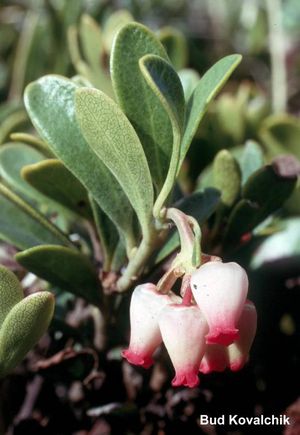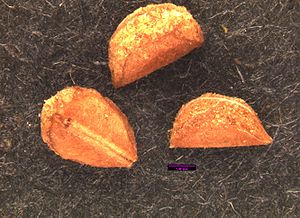Difference between revisions of "Arctostaphylos uva-ursi"
(→Description) (Tag: VisualEditor) |
(→Habitat) (Tag: VisualEditor) |
||
| Line 39: | Line 39: | ||
Ecological Setting-Coastal bluffs and prairies, rocky balds, dry subalpine meadows, and dry coniferous forest. | Ecological Setting-Coastal bluffs and prairies, rocky balds, dry subalpine meadows, and dry coniferous forest. | ||
Soil Texture-Medium and coarse textured soils | Soil Texture-Medium and coarse textured soils | ||
| − | Nutrients-Nitrogen poor soils | + | Nutrients-Nitrogen poor soils.<ref>Klinka et al., 1989</ref> |
Soil Reaction / Salinity-5.5-8.0 pH – medium salinity | Soil Reaction / Salinity-5.5-8.0 pH – medium salinity | ||
Moisture Regime Low moisture use – high drought tolerance | Moisture Regime Low moisture use – high drought tolerance | ||
Shade Tolerance Intermediate shade tolerance | Shade Tolerance Intermediate shade tolerance | ||
| − | Successional Status-Common in open canopy in young seral lodgepole pine forests | + | Successional Status-Common in open canopy in young seral lodgepole pine forests.<ref>Klinka et al., 1989</ref> |
==Uses== | ==Uses== | ||
Revision as of 12:51, 12 March 2021
- Latin Name: Arctostaphylos uva-ursi
- Family: Ericaceae
- Common Names: red bearberry, kinnikinnik
- Synonyms/Misapplications: Arbutus uva-ursi
- Codon: ARCUVA
| Arctostaphylos uva-ursi | |
|---|---|

| |
| Photo by Bernard Kovalchik. Also featured on Main Page | |
| Scientific classification | |
| Kingdom: | Plantae |
| Subkingdom: | Tracheobionta |
| Phylum: | Spermatophyta |
| Subphylum: | Magnoliophyta |
| Class: | Magnoliopsida |
| Subclass: | Asteranae |
| Order: | Ericales |
| Family: | Ericaceae |
| Genus: | Arctostaphylos Adans. |
| Species: | Arctostaphylos uva-ursi (L.) Spreng |
Contents
Description
General: Shrub; stems trailing across ground, less than 2 dm tall. Leaves: Alternate, 1-3 cm long, dark green, leathery, rounded at tip. Flowers: Light pink urn-shaped flowers in small clusters near tips of stems. Fruit: Bright red round berries 7-10 mm in diameter.
Prostrate shrub with somewhat stoloniferous rooting stems sometimes forming mats several meters wide; bark reddish to brownish, peeling off; stems ascending at the tip, 5-15 cm tall, minutely hairy, sometimes glandular. Leaves: Alternate, evergreen, leathery, egg- to spoon-shaped, 1-3 cm long, 0.3-1.2 cm wide, rounded at tip, rarely pointed, narrowed basally; entire, glabrous to minutely hairy especially on the margins and midrib, dark green above, paler below; stalks 2-5 mm long. Flowers: several in few-flowered terminal clusters; flower stalks 2-5 mm long, straight or curved, borne in the axils of hairy bracts; corollas pinkish-white, urn-shaped, 4-6 mm long, five lobed; clayces 1-1.5 mm long. Berries, bright red, 5-10 mm wide.[1]
Bloom Period
April - June[2]
Distribution
Alaska south to California and New Mexico, east to the Atlantic Coast; also in Eurasia.
Habitat
Ecological Setting-Coastal bluffs and prairies, rocky balds, dry subalpine meadows, and dry coniferous forest. Soil Texture-Medium and coarse textured soils Nutrients-Nitrogen poor soils.[3] Soil Reaction / Salinity-5.5-8.0 pH – medium salinity Moisture Regime Low moisture use – high drought tolerance Shade Tolerance Intermediate shade tolerance Successional Status-Common in open canopy in young seral lodgepole pine forests.[4]
Uses
Propagation
Seed
Seed sample from: 2009
Average Measurement: 3.9 x 2.3 x 1.8
Measurement Range: L: 3.75 - 4, W: 2.1 - 2.5, D: 1.5 - 2.25
Features
Shape: Fruits segmented with seeds like an orange. Individual seeds are orange segment shaped.
Color: Seeds brown. Hilum is a small brown dot on the ridge where the two flat planes of the segment come together.
Surface: Seed mostly smooth. Rounded surface of seed is ridged. It has a slight sheen on the flat planes.
Latitudinal Cross Section: triangular ![]()
Longitudinal Cross Section: elliptical ![]()
Basic Explanations and Assumptions:
The dimensions for the seeds are length x width x depth. The location of the hilum is used as the base of the seed, and the length is measured from hilum to the opposite apex. Where a style is present, the length is measured from the hilum to the bottom of the style. Width is measured at a right angle to the length at the widest part. Depth is measured at a right angle to the intersection of height and width lines.
Measurements included are the mean average for each measurement of ten separate seeds.
All measurements in millimeters unless otherwise noted.
Photo Gallery
References
- ↑ Douglas et al., 1999
- ↑ WTU Herbarium, Burke Museum, & University of Washington. Retrieved from http://biology.burke.washington.edu/herbarium/imagecollection/taxon.php?Taxon=Arctostaphylos%20uva-ursi
- ↑ Klinka et al., 1989
- ↑ Klinka et al., 1989


